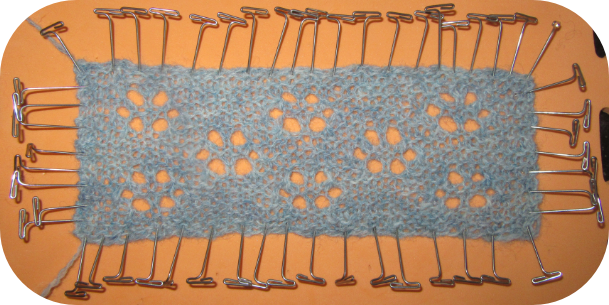Programme of events – Sunday 18 September
| General interest | Crochet | Hand knitting | Machine knitting |
8 – 9 am
| Breakfast Where: Dining room |
9 am
Board meeting (Board members only).
Clear bedrooms and checkout before 9:30 am.
9:30 am
Final checkout time.
10 am – 12:30 pm – Workshops
Workshops include a 30 minute break for refreshments.
Crochet Image credit: Anne Flannagan. | Beginners’ crochet Anne Flanagan Where: Derbyshire 5 Skill level… Complete beginner About me … I have been crocheting since my mid-twenties. Since then, I have learned many different crochet techniques. I try to combine my love of art and crochet to produce new patterns. The flexibility of crochet means the ability to create pictures and 3D models. In addition to teaching workshops for various organisations, I have taught many crochet sessions, across the county, for Hampshire Libraries from beginners to advanced. (Have crochet hook will travel!). Although I take my crochet seriously, I aim to make my workshops fun. So come along and use your “Chuckle Muscles”! About the workshop… The workshop will start right from the beginning with how to hold your hook and yarn. We will explore the importance of sound foundations. For folk who have tried crochet and got into a pickle (!) I will look at common beginners’ problems. We will make ‘scarf’ straight style crochet and work in circles. With these two techniques the whole world of crochet is open to you. I will explain how to read patterns and diagrams. As there are now more patterns and on-line teach in’s using the American terminology (hook sizes and names of stitches). I will explain and provide conversion tables to enable folk to make use of all these patterns. To bring with you… 4mm, 4.5mm or 5.0mm crochet hook, double-knitting acrylic yarn in several colours, scissors, paper, pencil/pen, eraser and (optional) a magnifying glass. |
Crochet  Image credits: Marjorie Needham. | Learn Double Filet Crochet Marjorie Needham assisted by Dianne Chan Where: Derbyshire 2 Skill level… Must have basic crochet skills (chains, double crochet, trebles and slip stitch). About me… Hello. I am Marjorie. I am 89 years old, and I was taught to knit when I was 5. In my teens, I learned crochet by myself. Since then, I have been teaching others informally and in schools. Currently I run my own group, “Knit with Marjorie”, in Bromley and I am a longstanding member of East London Crochet Group. I have been a member of the Guild since 1984. In 1986, there was a competition to design and knit a creative toy. My toy won and was auctioned for £700 for Save the Children funds. I have a photograph of Princess Anne presenting me with the award.We will be assisted by our Chair, Dianne, who is an experienced crocheter. About this workshop… This is a workshop for newcomers to learn double filet crochet. We will be making a double filet granny square. Double filet works two layers at the same time. The contrasting stitches make the pattern on the face of the square. The squares are thicker and warmer than traditional granny squares and are equally versatile. To bring with you… Please bring a 4.5mm crochet hook and double knitting yarn in two contrasting colours. 20 grams of each will be enough. If you bring a third colour, we can add it to the square. |
Crochet   Image credits: Margaret O’Mara | Mandalas in one colour or many Margaret O’Mara Where: Derbyshire 3 Skill level… This is an intermediate level of crochet, but most of the work is just chains and double-crochet. About me… I have been crocheting for just over 50 years, the last 30 includes teaching in several venues, including South Notts Collage (its name when I taught there). I have the Practical Diploma in Crochet, Master of Advanced stitches and Techniques from the USA, and teaching certificates to teach adults from both the USA and the UK. I enjoy teaching people tips they might not have come across that can improve the look of their work About this workshop… You will make a mandala using mercerised crochet cotton and a 2.50 mm hook. (If you want to use thicker yarn and bigger hook this is possible.) The mandala can be made in one colour, or as many as you want to use. You will learn how to do double-treble decrease, starting your stitches in different loops, a different place to put your hook when working double crochet and using packing thread. To bring with you… A 2.50 mm crochet hook and 50 grams No 2-crochet cotton to make something like the sample, but any yarn with the appropriate hook size is OK. |
Hand knitting  Image credits: Elspeth May. | Fearless steeks in Fair Isle Elspeth May Where: Derbyshire 7 Skill level… Intermediate About me… With some Scottish heritage, decades of knitting experience and a passion for colour, Fair Isle knitting is one of my favourite techniques. I have visited Shetland a number of times including Fair Isle itself and have learned much about the technique from knitters and designers there. I have run two workshops on this at Convention in the past and greatly enjoy sharing my enthusiasm for Fair Isle knitting with others. About this workshop… This workshop is for those who have some experience of knitting and feel ready to work with more than one colour, as well as those who may be familiar with stranded colourwork but are not yet confident about knitting and cutting steeks. And it may appeal to those who are comfortable with Fair Isle knitting and would enjoy working on a small project for a couple of hours to hone their skills.In the workshop, I shall briefly explain what distinguishes Fair Isle knitting from other forms of colourwork, how it developed and the motifs which characterise it, though we shall mostly focus on the practicalities. I hope that participants will leave the workshop feeling able to tackle any Fair Isle pattern of their choosing and perhaps with the motivation to create their own designs.In my experience, the questions most frequently asked about Fair Isle are:How many colours do I need to work with? (Remember, there are usually only two colours per row).What combination of colours should I use?How do I get the right tension when working with two colours?What is a steek?Won’t cutting my knitting make it fall apart?We shall answer all these questions in the workshop and any others which participants may come up with.My teaching style is hands-on and relaxed and there will be time to give one-to-one help to each participant who wants that. I hope it will be an enjoyable two hours for everyone. To bring with you…A set of DPNs in both size 3.00mm and 3.25mm. (You can use an appropriate-sized circular needle and Magic Loop if you prefer.)4ply (fingering weight) Shetland-style yarn. The most suitable yarns are Jamieson’s Spindrift and Jamieson & Smith’s 2ply jumper weight but other all wool, non-superwash yarns should be suitable. (If in doubt, please contact me in advance).Five shades of yarn are needed to make the tea cosy. I shall bring along a few oddments which could be used for the contrast colours, if needed.Quantity: 25g of the main shade plus smaller amounts of each of the four contrast shades.For the contrast colours choose one in a lighter tone of the main shade; a medium and lighter shade of quite a different colour; and a shade darker than the main colour.The sample pattern was worked inMC Jamieson’s Spindrift 710 gentian (dark blue)CC1 Jamieson’s Spindrift 524 poppy (warm red)CC2. Jamieson & Smith’s 2 ply jumper wt FC7 (pale copper)CC3 Jamieson & Smith’s 2 ply jumper wt 142 (mid blue)CC4 Jamieson’s Spindrift 1340 cosmos (charcoal)Stitch markers, a row counter and a pair of small sharp scissors. Before you come… Use 3.0 mm double pointed needles, cast on 112 stitches in the main colour. Join for working in the round, being careful not to twist any stitches. Place a marker at the beginning of the round.Work 6 rounds in K2, P2 rib.Change to 3.25 mm needles and work 2 rounds in knit.This established the start of the tea cosy. so that you are ready to set up the steek on the next round, at the workshop. |
Hand knitting  Image credit:s Steve Foreman. | Lace knitting for beginners Steve Foreman Where: Derbyshire 8 Skill level… Confident beginner. Able to cast-on, cast-off, knit and purl. About me… Steve started knitting in 2011 as a way of “turning off” from work. He quickly found that he preferred a challenge in his knitting, leading him to stranded work and lacy knitting. It didn’t take long to work out that lace work was easier to carry on his many business trips than stranded knitting. Adding his own motifs to baby blankets has taught him how much work must have gone into creating the motifs in the Shetland tradition, so he was happy to use a pattern for to knit a 1-ply Shetland lace shawl! About this workshop… Aimed at giving anyone who wants to knit something lacy but who is daunted by the prospect, this workshop will cover reading lace knitting patterns, knitting the lace, preventing, finding and correcting mistakes, and “dressing” the final piece. You will knit a bookmark with the traditional “Field of flowers” motif. To bring…. 10g of 4-ply smooth, solid light colour; 4mm knitting needles (straight or circular); dental floss or thick sewing thread in a contrasting colour; scissors or snips (or the cutter on dental floss container); darning needle; removable stitch markers (5) or thin yarn that you can use to make markers; pencil and rubber; paper (for making notes); 30 cm ruler or highlighter tape or magnetic board & rule. Before you come… Please cast on 37 stitches with the 4-ply yarn and garter stitch four rows (knit each row). This will form one border of your bookmark. |
Machine knitting  Image credits: Alison Peck. | Hand tooling techniques Alison Peck Where: Butterly 1 Skill level… Suitable for all levels. although ability to cast on and off is useful. About me… I got my first knitting machine in 1982, and machine-knitting is my design medium. I enjoy the process of moving from design and swatch to finished garment. About this workshop… Different makes and models of knitting machines work in slightly different ways, but all of them can be used with manual (hand-tooled) patterning. During this workshop, we will explore the slits and eyelets, bobbles, cables, beads, re-formed stitches, and edgings. Novices will become more comfortable with the tools, learning about stitch transfers (an important part of shaping) while more experienced knitters can experiment more widely. To bring with you… Yarns and all equipment will be provided. Please make sure you are not wearing loose (especially knitted) sleeves. (If you want to bring your own machine, please check first.) |
General interest Image credit: Lindy Zubairy. | How to teach a craft Lindy Zubairy Where: Derbyshire 4 Difficulty level… Intermediate or advanced crocheters who would like to teach. About me… I graduated in Fashion Design in 1984 from Epsom School of Art and Design. Achieved my PGCE in Design & Technology in 2006 from Goldsmiths, University of London and taught in secondary schools for three years. Have been regularly freelance writing and designing for various crochet magazines since 2011, and teaching crochet at all levels at the Women’s Institute college from 2012 until it closed last year. I also teach elsewhere on an ad hoc basis, and I published my book, Popcorns, Bobbles and Puffs to Crochet in 2016 through Quarto. About this workshop… During this short workshop, Lindy will share her tried and tested approach to introducing the craft to adult beginners and improvers everywhere and inspiring them to keep on crocheting afterwards. She’ll be taking a look at lesson planning and resourcing, breaking down barriers to learning, differentiating for various kinds of learners and how to troubleshoot, resolve, or even avoid, common beginners’ mistakes and pitfalls. You’ll be encouraged to share your own experiences in discussions on ‘professionalism’ and what that looks like in this context, flexibility, teachers’ terms like ‘pacing’ and ‘chunking’, what makes a good teacher, what stops learners from learning, and how your subject knowledge helps or hinders. Lindy is full of tips and tricks, picked up over years of teaching crochet to beginners and improvers alike, and she will show you her ’system’ for layering learning so that each new skill level builds comfortably on the last. Bring a big notebook and a couple of pens! To bring with you… Notebook and pens. |
Break – workshop leaders will tell you whenRefreshments
Where: Bars
12:30 – 1:30 pm
| Lunch Where: Dining Hall |
2 – 3 pm
General interest  Image credits: Sandy Black. | Keynote: Classic Knits of the 80s Professor Sandy Black Where: Butterly 1 About me…Sandy is a designer, author and educator, and started her career studying maths. Having been taught to knit and crochet as a child, she rediscovered knitting (by hand and machine) whilst at university and became fascinated by the creative possibilities that knitting offered. She built up a business designing one-off pieces for special projects and clients, then selling her unique designs (including landscape sweaters and luxurious evening coats) to prestigious fashion stores worldwide. She developed the Sandy Black range of colourful knitting yarns and pattern kits, selling internationally. After over 15 years in business, Sandy began lecturing, running undergraduate courses at University of Brighton, then postgraduate courses at London College of Fashion LCF. She has published key books on knitwear and knitting history, and also on sustainable fashion. Sandy is professor in LCF’s Centre for Sustainable Fashion, developing research projects and supervising PhD students. Sandy is also Chair of the UK Knitting History Forum. About this talk … This talk will look at the new wave of British knitwear designers that emerged in the late 1970s and 1980s, that was named a ‘Knitwear Revolution’ by fashion writer Suzy Menkes in her 1983 book of the same name. These designers took a fresh and colourful approach to knitwear, each working with a craft-based style that was distinctive. The talk will particularly present Sandy’s own work of the period, under her label Sandy Black Original Knits, working in both exclusive ready-to-wear knitwear – selling in outlets such as Saks 5th Avenue in New York, Browns in London and Isetan in Tokyo – and in hand knitting kits for the home knitter, selling across the UK (e.g. in Liberty, John Lewis), and in the USA, Europe and Australia.Sandy has always worked with both hand and machine knitting, as appropriate. Now 20 hand knitting patterns from the 1980s are recently published in Classic Knits of the 80s (Crowood Press 2021), many for the first time. The designs are themed into five groups: Textural, Graphic, Floral, Heraldic, Ornamental and Fun Accessories. The talk also includes a look at Sandy’s inspirations and her knitwear design development process This event will be recorded. |
3:15 – 3:30 pm
General interest Image credit: Dianne Chan. | Closing remarks Dianne Chan Where: Butterly 1 |
4 pm
Deadline for leaving

